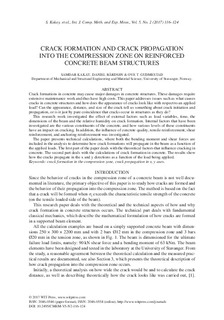| dc.contributor.author | Kakay, Samdar | |
| dc.contributor.author | Bårdsen, Daniel | |
| dc.contributor.author | Gudmestad, Ove Tobias | |
| dc.date.accessioned | 2018-08-31T13:04:27Z | |
| dc.date.available | 2018-08-31T13:04:27Z | |
| dc.date.created | 2017-01-09T11:55:04Z | |
| dc.date.issued | 2017 | |
| dc.identifier.citation | Kakay, S., Bårdsen, D., Gudmestad, O.T., (2017) Crack formation and Crack propagation into the compression zone on reinforced concrete beam structures. International Journal of Computational Methods & Experimental Measurements. 5(2), pp. 116-134. | nb_NO |
| dc.identifier.issn | 2046-0546 | |
| dc.identifier.uri | http://hdl.handle.net/11250/2560323 | |
| dc.description.abstract | Crack formations in concrete may cause major damages in concrete structures. These damages require extensive maintenance work and thus have high costs. This paper addresses issues such as what causes cracks in concrete structures and how does the appearance of cracks look like with respect to an applied load? Can the appearance, distance, and size of the crack tell us something about crack initiation and propagation, or is it just by pure coincidence that cracks occur in structures as they do?
This research work investigated the effect of external factors such as load variables, time, the dimensions of the beam and the relative humidity on crack formation. Internal factors that have been investigated are the various constituents of the concrete, and how various levels of these constituents have an impact on cracking. In addition, the influence of concrete quality, tensile reinforcement, shear reinforcement, and anchoring reinforcement was investigated.
The paper presents technical calculations, where both the bending moment and shear forces are included in the analysis to determine how crack formations will propagate in the beam as a function of the applied loads. The first part of the paper deals with the theoretical factors that influence cracking in concrete. The second part deals with the calculations of crack formation in concrete. The results show how the cracks propagate in the x and y directions as a function of the load being applied. | nb_NO |
| dc.language.iso | eng | nb_NO |
| dc.publisher | WIT Press | nb_NO |
| dc.subject | crack formation | nb_NO |
| dc.subject | crack propagation | nb_NO |
| dc.subject | cracks in concrete | nb_NO |
| dc.title | Crack formation and Crack propagation into the compression zone on reinforced concrete beam structures | nb_NO |
| dc.type | Journal article | nb_NO |
| dc.type | Peer reviewed | nb_NO |
| dc.description.version | publishedVersion | nb_NO |
| dc.rights.holder | © 2017 WIT Press, www.witpress.com | nb_NO |
| dc.subject.nsi | VDP::Technology: 500 | nb_NO |
| dc.source.pagenumber | 116-134 | nb_NO |
| dc.source.volume | 5 | nb_NO |
| dc.source.journal | International Journal of Computational Methods & Experimental Measurements | nb_NO |
| dc.source.issue | 2 | nb_NO |
| dc.identifier.doi | 10.2495/CMEM-V5-N2-116-124 | |
| dc.identifier.cristin | 1423244 | |
| cristin.unitcode | 217,8,5,1 | |
| cristin.unitcode | 217,8,5,0 | |
| cristin.unitname | Laboratorium IMBM | |
| cristin.unitname | Institutt for maskin, bygg og materialteknologi | |
| cristin.ispublished | true | |
| cristin.fulltext | original | |
| cristin.qualitycode | 1 | |
